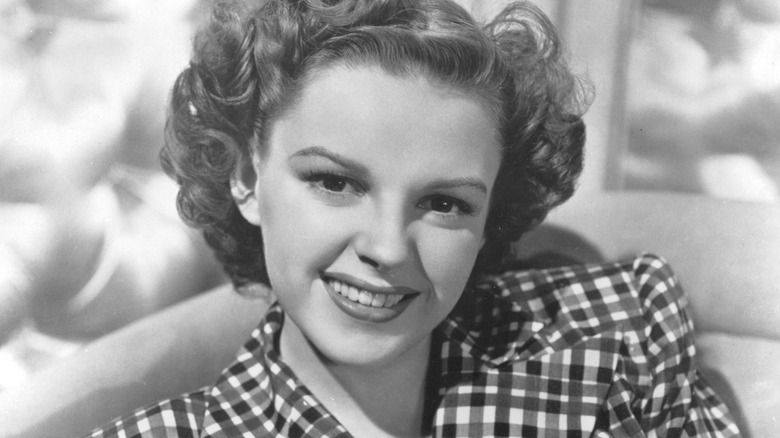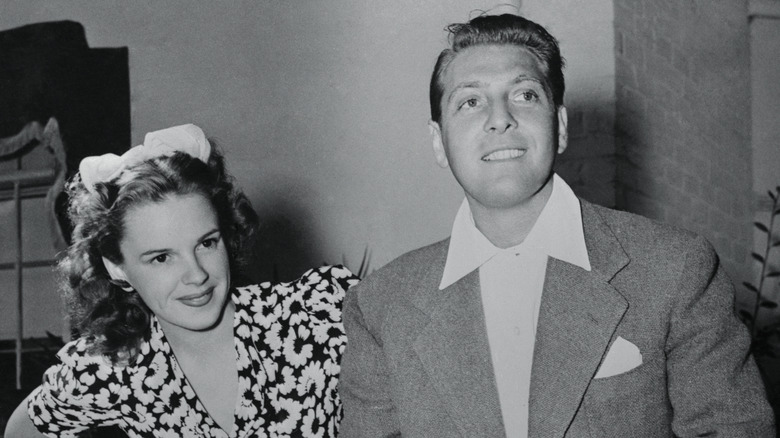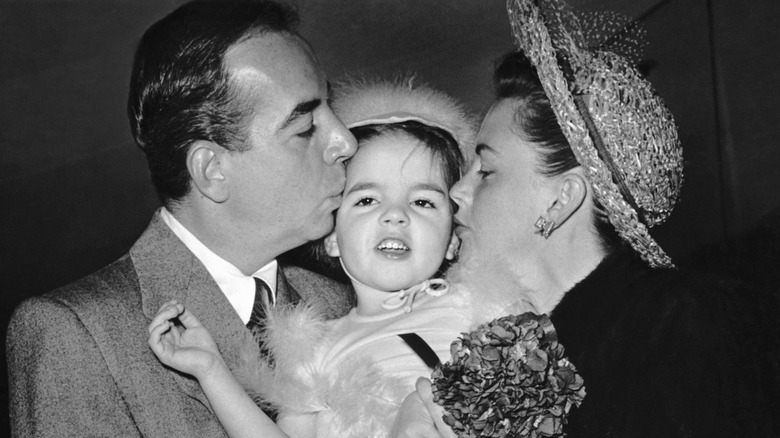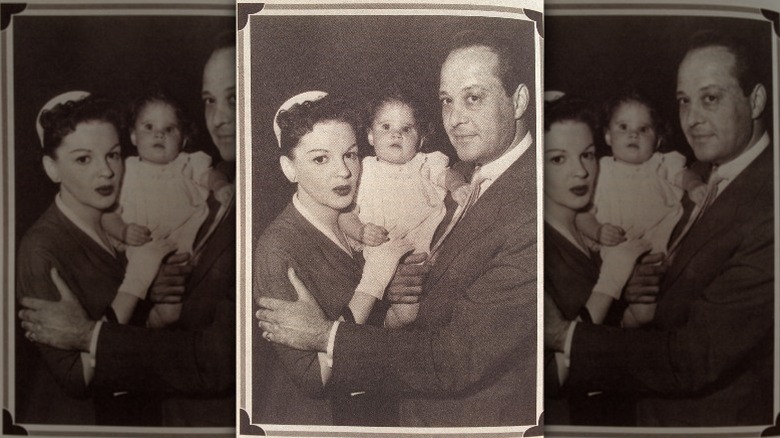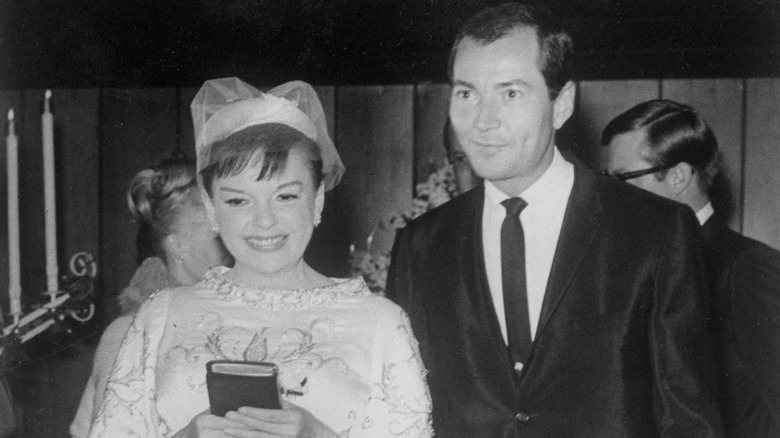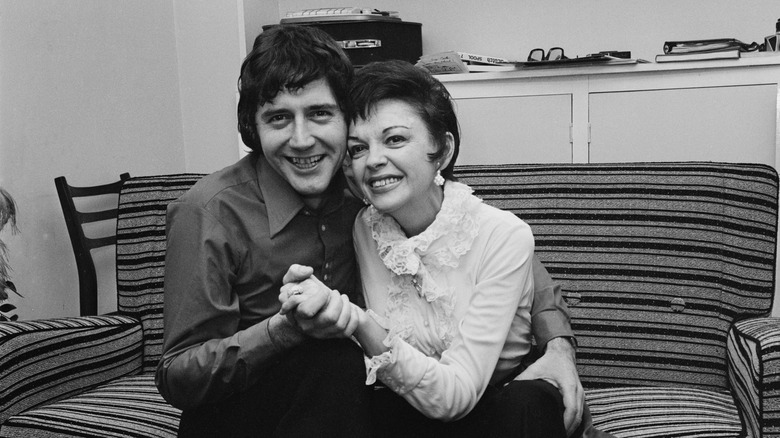The Tragedy Of Judy Garland's Love Life Is So Sad
We may receive a commission on purchases made from links.
The following article includes mentions of addiction, mental health issues, and domestic abuse.
The truth of Judy Garland's life painted a much less glamorous picture than what we saw on the silver screen. "The Wizard of Oz" star's issues stemmed from childhood, when her own mother started giving her stimulants to get her to keep up with the studios' demanding hours, followed by sleeping pills to counteract the effects of the so-called "pep pills." Garland claimed the studios themselves then picked up the practice. By adolescence, she was suffering from a pill addiction. The tragedies experienced in her love life did nothing to help.
Garland's five marriages were marked by forced abortions, infidelity, and physical and emotional abuse. Shortly after marrying David Rose at 19, Garland was talked into ending a pregnancy against her will to avoid tainting the virginal image that sold so well. She was forced to have a second abortion by her third husband, Sid Luft, when she was still married to Vincente Minnelli. But her second marriage was done by then. Garland caught Minnelli cheating with a man, an event that drove her to attempt to take her own life for the first time.
Throughout her marriage to Luft, Garland's attempts grew more frequent as she struggled with addiction and physical abuse. Her fourth husband, Mark Herron, reportedly had a shocking affair with her daughter's husband. She finally thought she found true love in Mickey Deans, but her loved ones believed he took advantage of her, often forcing her to perform when she was ill. Garland's love life proved to be as turbulent as her public life.
David Rose coerced Judy Garland to have an abortion
Judy Garland became a married woman for the first time right when she became a global movie star. Garland was just 19 when she wed the composer David Rose, who was 12 years her senior, in July 1941. Metro-Goldwyn-Mayer wasn't happy about the wedding. Being married just didn't suit the image they wanted for their golden girl. But they could do little about it. When Garland fell pregnant, there was something more concrete that could be done. "Married or not, the MGM girls maintained their virginal image," Jane Ellen Wayne noted in "The Golden Girls of MGM" (via Vanity Fair).
It helped that Rose was equally unhappy about the pregnancy. By then, Garland and Rose were having marital troubles. "When I found myself in that big house with him, it was frightening," Garland said, according to biographer Gerald Clarke in a 2016 Architectural Digest piece. "I didn't know anything about cooking or keeping house. I was very vague and quite impractical." Aside from music, they discovered they had little in common. But Garland was excited at the prospect of becoming a mother despite their differences.
Rose was not. And so MGM jumped at the chance to enlist his and Garland's mother's help to convince the actor to have an abortion. She did, but the procedure had a deep impact on her mental health, and the marriage was over soon after. "Something was gone," she told a friend, according to Clarke. In 1944, they divorced.
Judy Garland attempted to take her own life during her marriage to Vincente Minnelli
Judy Garland wasn't single for long. In June 1945, she tied the knot with director Vincente Minnelli, with whom she fell in love during the production of "Meet Me in St. Louis" the previous year. Nine months later, Garland gave birth to Liza Minnelli. All seemed to be going well, but Garland soon began to resent her second husband. As an influential director, she believed he could do more to propel her career. "It was a conflict of interest," Sid Luft, Garland's third husband, wrote in "Judy and I: My Life with Judy Garland."
Barely two years into the marriage, the two had grown apart to the point of affairs. In 1947, Garland walked in on Minnelli in their bed with a man who had been working with both of them on "The Pirate," Gerald Clarke revealed in "Get Happy: The Life of Judy Garland" (via Vanity Fair). Garland, who had also been having an affair with "The King and I" star Yul Brynner at the time, was likely more shocked at learning about her husband's sexuality than the affair itself. It sent an already fraught Garland over the edge.
Garland went into the bathroom and attempted to take her own life for the first time. Minnelli prevented her from going through with it. By that point, the actor's mental health had been struggling amid career downturns and her addiction to amphetamines and sleeping pills. After MGM suspended her contract in 1950, she attempted to take her own life once again. Her marriage to Minnelli ended the following year.
Garland's marriage to Luft was plagued by several issues
In 1951, when Judy Garland was still legally married to Vincente Minnelli, she fell pregnant by Sid Luft. The "A Star Is Born" producer, key in Garland's career comeback, thought the news was devastating. As both were married to other people, the publicity would be bad for the show they were working on. He had the misogynistic reaction of blaming her. "I thought she was purposefully not cautious," Luft wrote in "Judy and I."
After witnessing his outburst, Garland quietly terminated the pregnancy. "Judy didn't confide in me where and when she was going to have the abortion, so I didn't go with her," he wrote. Despite this complicated start, Garland and Luft wed the following year. She got pregnant again and gave birth to their daughter, Lorna (seen above), five months later. However, the issues that afflicted Garland's previous marriages caused tension with Luft.
Garland's mental health continued to deteriorate in light of her addiction, now aggravated by medication prescribed for postpartum depression and diet pills. Luft thought he could manage her addiction himself. "In hindsight, I was enabling," he wrote. That wasn't the only role he played in their marriage's collapse. When she filed for divorce, Garland accused Luft of physical abuse. "He struck me many times," she told the judge (via The New York Times). "He did a lot of drinking." Throughout their 13-year marriage, Luft claimed Garland attempted to take her own life at least 20 times. They divorced in 1965.
Judy Garland and Mark Herron's marriage was marked by violence and a shocking betrayal
Like her previous marriages, Judy Garland's relationship with Mark Herron started before her divorce from Sid Luft. Only this time, she married her fourth husband before divorcing her third. In June 1964, she and Herron held a ceremony off the coast of Hong Kong. "We found and hired a boat for the wedding, and it is a fairly big ship, but I cannot remember its name," he told The New York Times. Garland's manager, Freddie Fields, played down the legal implications of the ceremony.
But Garland was adamant about her intention. "[It is] absolutely legitimate," she said, according to the Los Angeles Times. Regardless of the message she wanted to send, the Hong Kong ceremony wasn't legally binding. That happened more than a year later, when the couple wed in Las Vegas in November 1965.
Herron would reportedly become the second of Garland's husbands to cheat on her with another man. However, this wasn't just any guy: Herron is said to have had an affair with Liza Minnelli's first husband, Peter Allen. As such, mother and daughter joined the list of famous women who unknowingly dated gay men. It's unclear when the supposed relationship happened, but Garland and Herron separated five months after their wedding. During the divorce, she accused Herron of physical abuse. He didn't deny it, though he accused Garland of the same. "[I] only hit her in self defense," he said, the LA Times reported.
Mickey Deans made Judy Garland perform against medical orders
Judy Garland met Mickey Deans, a jazz musician and club manager who was 12 years younger than her, in 1967, about a year after her split from Mark Herron. The meeting was anything but romantic. He showed up at her hotel room posing as a doctor to deliver stimulants in the middle of the night. They wed two years later. While Deans played the devoted husband part well in public, for those close to Garland, it was all for show.
Lorna Smith, who worked as the actor's backstage assistant during her finals days, claimed Deans often took advantage of Garland. Even though Garland was still in her 40s, her health reflected the consequences of decades of addiction and the horrific ways old Hollywood studios abused actors. But Deans reportedly didn't care, often coercing her to perform at Talk of the Town against doctors' orders. Friends saw Garland performing with a fever.
"She is ill and she is being forced onto that stage tonight!" Smith recalled one saying in her book, "Judy, with Love" (via HuffPost). Garland's daughter, Lorna Luft, was disgusted to see Deans negotiating a biography on the day of her funeral. He published "Weep No More My Lady" three years after Garland's mysterious death in 1969, three months into their marriage. "Needless to say, I didn't buy a copy. Mickey Deans. What a putz," Luft wrote in "Me and My Shadows: A Family Memoir" (via The Wrap).
If you or anyone you know needs help with addiction issues, mental health support, or is dealing with domestic abuse, contact the relevant resources below:
- The Substance Abuse and Mental Health Services Administration website or contact SAMHSA's National Helpline at 1-800-662-HELP (4357).
- If you or someone you know is struggling or in crisis, help is available. Call or text 988 or chat 988lifeline.org
- The National Domestic Violence Hotline at 1−800−799−7233. You can also find more information, resources, and support at their website.

